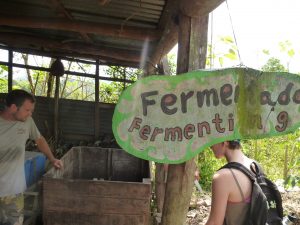The short walk down the dirt road, passing a small purple house and cows lounging on a hillside, our noses were greeted by the poignant, rich smell of pure chocolate that led us to a chocolate farm.
This chocolate farm, La Iguana Chocolate, is maintained by Juan Luis and his family. His family began the production of chocolate with pure cacao seeds and unrefined pure cane sugar in 2005, after studying eco-tourism. The land holds approximately 3,000 cacao trees about 2 meters in height with branches extending out that produce cacao pods growing from the trunk of the tree. The trees produce the cacao fruit year round with peaks from September to November and throughout May and June. Each tree usually produced 30 pods of the fruit in one year. The trunk is lined with flowers but only 2% are fertilized and produce fruit. This small percentage is due to the only pollinating insect, the Loca fly.
 Juan Luis led us through the process of producing a fine quality chocolate, with the help of a translator. The steps are as follows:
Juan Luis led us through the process of producing a fine quality chocolate, with the help of a translator. The steps are as follows:
- Once the pods turn yellow, they are cut off using a machete. The pods are opened and the seeds are extracted from the central area.
- The seeds are placed in a fermenting bath. Fun fact: the fermenting bath is as old as the farm! The seeds are enclosed in a soft texture of white goo, so in order to extract the seeds they are placed in a fermenter so the goo can be dried and seeds collected.
- The seeds are then placed on a screen to be dried out for 3-4 days, then 1 day in direct sunlight. The farm used to use a tarp but the seeds were not drying enough so they switched to a screen method. Also, if the seeds are stored properly in plastic bags they can be kept for up to 2 years!
- Next the seeds are roasted for about 20 minutes and are let stand to cool.

- The seeds are then shelled. (Our group was put to work at this step.) At this stage, you can really taste the chocolate, but without any sweetener they are very bitter! Hardly anyone liked the taste.
- The seeds were then placed in a homemade electric grinder. This grinder was created by an engineer from Ireland that was working the farm as a volunteer. The grinding resulted in a paste like substance. The paste could then be pressed to extract coco butter. The coco butter is used in several other products they make, like soap, chapstick, or placed back in the chocolate to add richness.
- The pressed powder/paste is then mixed with tapa dulce, also known as sugar cane. The tapa dulce is preferred because it local, healthier and stronger in flavor.
- The mixture is then placed into a spinner, which creates a finer mix, allowing the flavor to be blended in evenly.
- The La Iguana Chocolate final step is to weigh out 11g of the blend which is placed into plastic molds the size of three stacked quarters to then be sold…or eaten!
Juan Luis and his staff gave us unforgettable behind the scenes look into seeing the purity of creating their delicious chocolate. And although it didn’t quite look like Willy Wonka’s chocolate factory, it tasted just as yummy!
